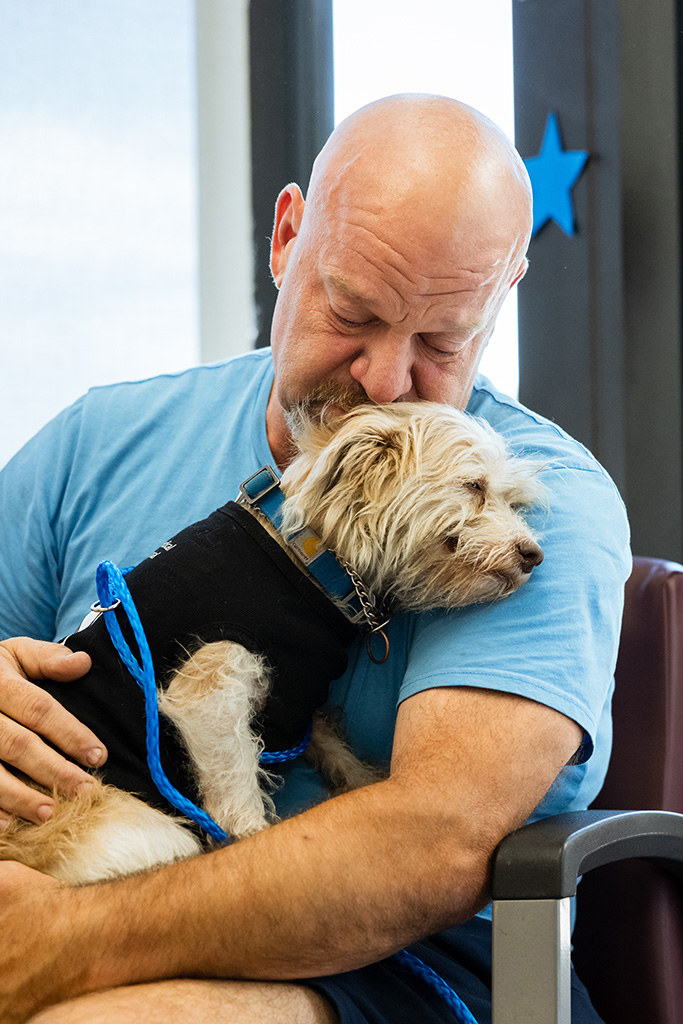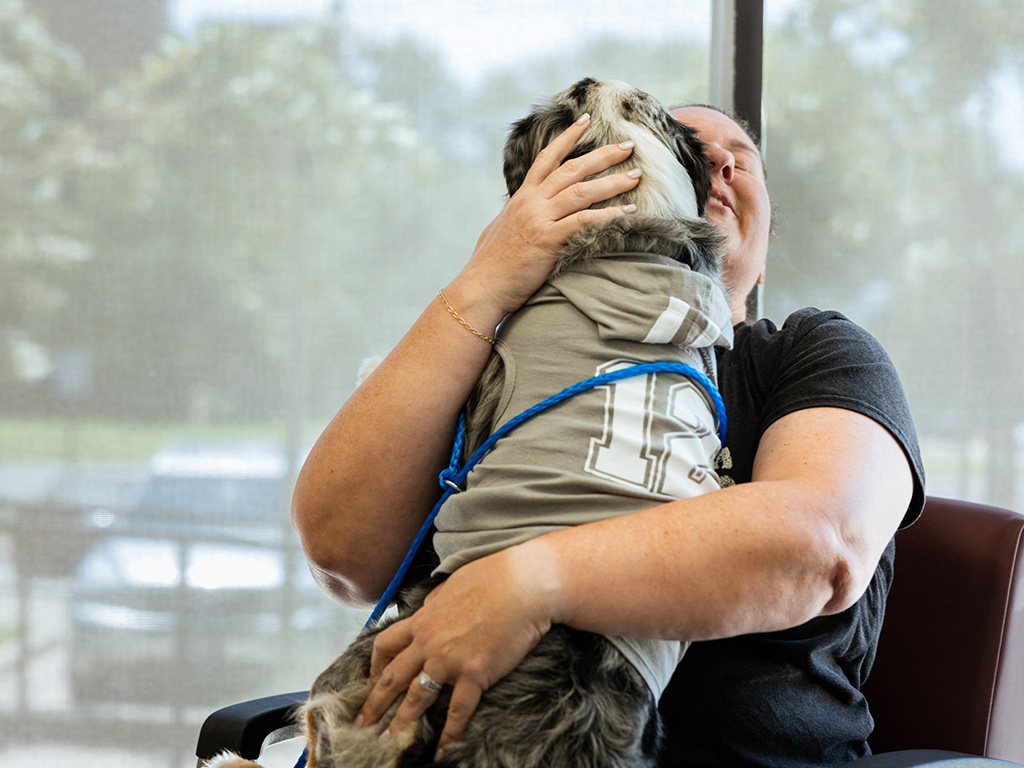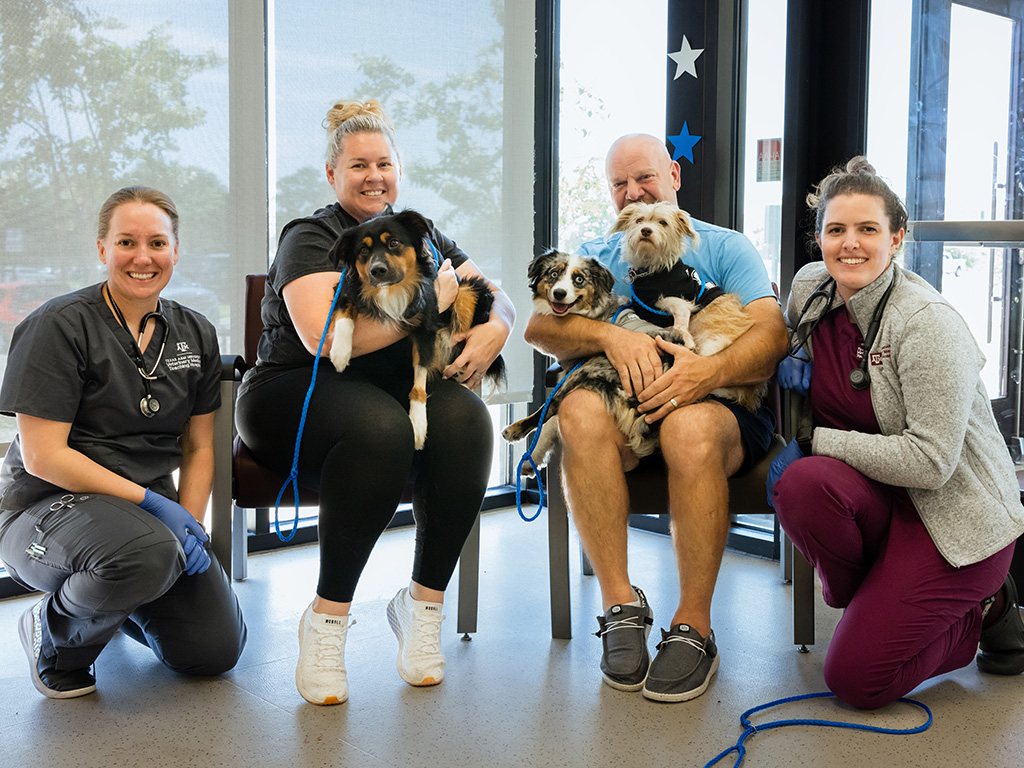Texas A&M Veterinarians Help Dogs Make Miraculous Recovery After House Fire
Story by Megan Bennett, College of Veterinary Medicine & Biomedical Sciences

The word “miracle” has taken on a deeper and more personal meaning for Kris and James Dent after a house fire that burned for two hours nearly claimed the lives of their beloved dogs.
But because of quick thinking and appropriate care from family members, first responders, and a veterinary team at the Texas A&M Small Animal Teaching Hospital (SATH), all three dogs, incredibly, survived and are now back home with their owners.
“If the EMTs hadn’t responded as they did, or if the owners hadn’t gotten them here so fast, the dogs might not have made it. They’re very lucky to be alive,” said Dr. Shayna Doyle, a second-year veterinary resident at the SATH who oversaw the dogs’ care. “It’s a miracle that they survived long enough to get to Texas A&M and that they will likely have no long-term side effects.”
A Freak Accident
In early July, the Dents moved into their new home in Waller, Texas, with their dogs — a 6-year-old mixed-breed named Hank and two young Australian shepherds named Austin and Texas.
When the couple left for a shopping trip in Brenham five days later, they never imagined that their ordinary Sunday afternoon would become one of the most unforgettable days of their lives.
As it was later determined by a fire inspector, a lightning strike to their house’s chimney caused the stove to catch fire. Because of the home’s thick insulation, the fire burned for two hours before James’ mother, Connie Zdawczyk, noticed from her house next door that smoke was coming out of the Dents’ vent hood and called the fire department.
“My mother-in-law tried to call me first but it didn’t go through, so then I got a call from my stepdaughter, Brandy, who said our house was on fire,” Kris recalled. “The first thing I thought was, ‘My dogs are in there.’ That’s the first thing you think of — your babies. I was 30 minutes away, so I told them that somebody needed to go save my dogs.”
As word of the fire spread quickly through the family, Brandy’s mom and stepfather, Brooke and Scott Robinson, and stepsister Natalie rushed to the house and immediately broke down the side door, despite the fire department’s warnings.
“The smoke was so bad that my mother-in-law couldn’t even see through our glass door,” Kris said. “But Scott, Brooke, and Natalie went in and got the dogs out. Brooke, who’s a paramedic for Austin County, knew what to do and started giving Hank mouth-to-mouth right away. They saved all three of our dogs’ lives.”
The first responders on the scene provided canine oxygen masks, and with help from the Dents’ family members, they had just finished reviving the dogs when Kris and James arrived.

“The first responders absolutely saved their lives,” Doyle said. “Providing oxygen increases the rate of carbon monoxide being eliminated by the body. The first responders gave a high dose of oxygen to the dogs immediately, which likely helped the carbon monoxide levels decrease almost immediately.”
The Dents rushed the dogs to the nearest veterinary clinic, but because of the potential dangers of prolonged smoke inhalation and oxygen deprivation, the local veterinarian recommended that the dogs be taken to the SATH’s Emergency & Critical Care Service.
Although the three dogs were conscious when they arrived at the hospital later that evening, they were nowhere near finished with their fight to survive.
Continuing The Battle
“When the dogs came in, they were still very oxygen-dependent,” Doyle said. “You could see the carbon monoxide poisoning in their bloodwork. Austin was also quite lethargic and hypersalivating profusely.”
As the dogs continued to receive supplemental oxygen and other supportive care, it soon became apparent that Austin had lost her sight during the trauma.
“In a fire situation, it’s possible to have a brain injury because not enough oxygen is getting to the brain and high levels of carbon monoxide are building up in the body,” Doyle said. “That can manifest as blindness, but it’s not that their eyeballs themselves can’t see; it’s that their brain is injured and can’t understand vision anymore.
“There is a chance that she’ll be blind forever, but sometimes they can continue to improve, so it’s possible that she’ll regain her vision,” she said. “Luckily, dogs that become blind do incredibly well and can live normal lives.”
Although the three dogs were released to go home two days after their arrival, Austin returned later that evening for more complications, including a seizure. Fortunately, she recovered without damage and was released again one week after the fire.
“I could really tell the vets cared for Austin, Hank, and Texas the whole time,” Kris said. “It felt like a family. When we got to take them home, that was just the best feeling ever.”
Compassion In Action

While the dogs were at the SATH, Doyle took her commitment to care a step further by ensuring that the Dents would also receive financial support from one of the SATH’s Compassionate Care Funds.
“Knowing their situation, I wanted to take a little burden away from them however I could,” Doyle said. “Thanks to the generosity of people who donate to our Compassionate Care Funds, that relief came in the form of financial assistance to cover Austin’s, Hank’s, and Texas’ veterinary care.”
Supporting others in their greatest time of need is at the heart of selfless service — an Aggie core value used daily in the SATH to provide compassionate care. Donors who give to the Compassionate Care Funds empower Texas A&M veterinary teams to help people like the Dents who’ve lost nearly everything except their pets and the hope they represent.
“When you go through all that, you just don’t know how you’re going to make do. The money we’ve had to spend out of pocket already has just been overwhelming,” Kris said. “When they blessed us by taking money off our bill, that showed how much they care about animals and people. The heart really shone through.
“I’d recommend Texas A&M’s veterinary hospital to anybody and everybody,” she said. “I’m a big University of Texas fan, but A&M has my heart now.”
###
For more information about the Texas A&M College of Veterinary Medicine & Biomedical Sciences, please visit our website at vetmed.tamu.edu or join us on Facebook, Instagram, and Twitter.
Contact Information: Jennifer Gauntt, Director of VMBS Communications, Texas A&M College of Veterinary Medicine & Biomedical Sciences, jgauntt@cvm.tamu.edu, 979-862-4216


